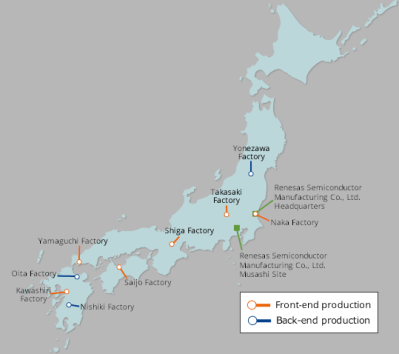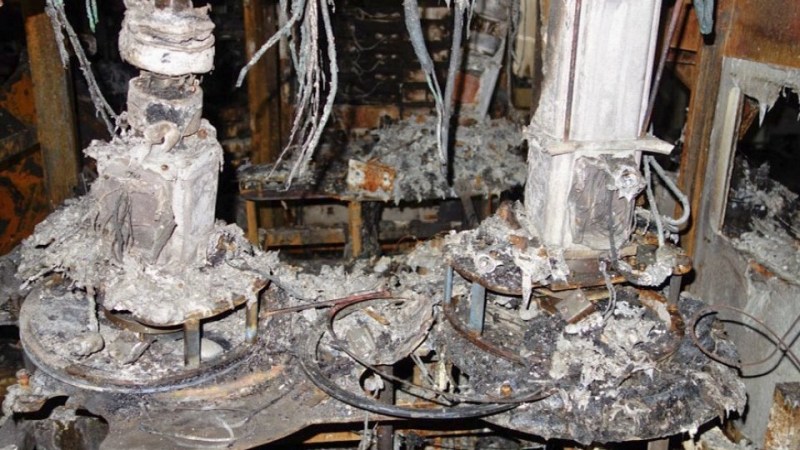The small city of Naka (pop. 53K), a two-hour train ride from Tokyo on the eastern coast of Japan, was thrust into the international spotlight in the early dawn of Friday morning. A fire broke out among electroplating equipment in Renesas’s 300 nm N3 fabrication facility. It was extinguished before breakfast time, and fortunately nobody was injured nor were there any toxic chemical leaks. Only six hundred square meters on the first floor of the plant was damaged, but the entire building has to be closed for repairs. It will take approximately one month to restore normal operations, and CEO Hidetoshi Shibata is “concerned that there will be a massive impact on chip supplies”.

In a press conference on Sunday afternoon, Renesas reports that the source of the fire has been determined, but the details are still unclear:
The casing of the equipment and the plating tank have relatively low resistance to heat, and the equipment ignited due to overcurrent. However, the cause of the overcurrent and the reason for the ignition is currently being investigated.
Semiconductors are already in short supply, as we reported back in January, forcing slowdowns at many auto manufacturers. The Naka plant primarily makes automotive semiconductors, worsening an already stressed supply chain. While the news focuses on the automotive sector, this shortage spills over into many other industries as well.















Another chip plant fire in Japan? Yikes. I guess they’re all running skeleton crews due to COVID and aren’t able to keep up with their maintenance backlogs?
Or more likely push production lines to 11 to keep up with orders, until they literally burn.
You can click through to the article where the cause is revealed!
Not really. TFA just says the same as the summary, it was a fault in the plating equipment due to too much current. No word on why there was too much current.
No it isn’t exact but it certainly eliminates the “overproduction” speculation.
It is happening everywhere. Work at home only works for people who can truly work from home 100%.
While this is more bad news for big corporates whose products depend on semis, it’s an even bigger problem for small companies or start-ups trying to launch a hardware product. Start-ups don’t have strong supply chains or leverage, and building from “Digikey” inventory is pretty much impossible right now. In fact it’s much worse right now than any other cycle I recall (DRAM, tantalum shortage 20 years ago, etc.). Key parts are suddenly at 40-52 weeks lead-time. Hardware is never easy but it’s an especially tough time right now!
I recall when I worked for a small telecom company in the early 90’s that certain microcontrollers were in short supply because automotive customers got priority.
I think it’s really cool that Renesas appears to keep all their manufacturing domestic. We waste so much time saving a bit of money by having fab in one country, packaging and test in another, design and physical verification in another, and all these parts in various stages of completion bouncing back and forth between them.
Till one gets an earthquake in the most inopportune place. And les we forget back when HDD manufacturing was impacted by flooding.
Putting all your eggs in one basket is usually not a good idea. The world is an unpredictable place. Distributed and redundant supply chains seem inefficient but they will keep running even with natural disasters, fires, tsunamis, plagues, volcanos, etc.
Wars?
Fully agree. Many are not aware that the power outages in TX impacted resin production that affects MANY consumer products. Those companies have been combing the globe to find alternate sources of resin to keep things like baby diapers on the shelves.
Renesas also has subsidiary fabs in China and Malaysia
I’m quite sure several product lines of theirs are manufactured by TSMC. It’s mostly their automotive business that stays in-land.
Is this one of those mysterious fires that happens in oil refineries right about the time the industry needs a price hike? I also don’t underestimate anyone’s capability to manipulate market pricing for things. I for one find it very hard to believe that a high tech manufacturing plant does not have the detection and suppression systems to handle a fire before it engulfs an area that large. 600 square meters is a pretty big area to lose control of. I worked in Japan for several years in the construction industry and found their fire safety standard to be pretty robust in most cases.
600 sqm were damaged, not lost control over. You ever see what smoke does to the parts of the building that flames never touch? This is a controlled environment, cleaner then an operating room. Everything has to be cleaned and the line restarted, making chips takes surprisingly long, hence the month of delay.
Also, in one of the reports I read, some of that damage was to a clean-room. I imagine that is significantly more work to cleanup than, say, office and factory areas. They also noted that the entire second floor is un-touched and usable. However, the integrated flow of products uses both floors. I wonder if they’ll rethink that product flow during the repairs.
It take a month or more to *restart* a fab in planned ways.
When this kind of thing happens, it’s mainly a write off for the fab.
A little more insight on the impact of a sudden stop in a fab:
https://www.nxp.com/company/blog/through-the-storm-the-complex-process-of-restarting-a-semiconductor-facility:BL-RESTARTING-SEMICONDUCTOR-FACILITY
This was a great read, @hackaday should feature it on its own merits.
EXACTLY! I design and manage large telecommunications systems and projects, “critical infrastructure” if you will. Entire facilities have multi-zone multi-sensor fire detection, automatic zone compartmentalization, and automatic Halon (Halomethane variant or similar) fire suppression systems. With proper maintenance and monitoring these places are designed to be essentially fire-proof (99.9+ % lifespan confidence). Just in-case, technical and security personnel do monitor the systems and facilities 24×7. These people are also equipped, professionally trained, and periodically tested in fire control methods, just in case.
Why isn’t this being done at all these multi-billion dollar semiconductor fabs and electronics factories that keep burning up? Sheesh, their fire insurance premiums must end up costing orders of magnitudes more than installing a state of the art automatic fire suppression system. This doesn’t add up.
Just in time supply chain bites back.
300 nm or 300 mm? If mm, what does this measurement refer to?
It’s 300 mm and it refers to the size of the wafers.